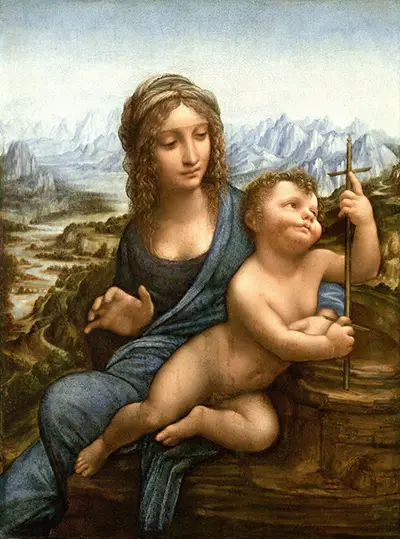Madonna of the Yarnwinder
Madonna of the Yarnwinder is a painting done in oils on canvas by Leonardo da Vinci and is widely believed to have been started around 1499 or maybe a little later, the exact date is unknown. He was recorded as having been working on this painting in Florence in 1507, a commission from Florimonde Robertet, a secretary to King Louis XII of France. This painting is said to have been delivered to the French court in 1507, so presumably it was also finished in that year.
The virgin Mary is shown seated, with the child Jesus lying across her lap to the right side where he is holding on to his mothers yarnwinder, a cross being created by the top spokes of it. The yarnwinder, used to collect spun yarn, was used during the age in which this picture was painted, by the women of the household to wind the yarn before it could be later spun into wool in order to make garments for the family, and things needed for the home. it is used in this context as a symbol of the Madonna's domesticity, and the cross formed by the top spokes as a symbol of Christs crucifixion. At first glance it would seem that the child is using the yarnwinder as a plaything, though some sources say that Da Vinci has painted him thus to represent acceptance of his eventual destiny. It is up to the admirers of his work to make up their own minds as to which, if either, version is correct. The Madonna is portraid as a young and pretty woman wearing a cobalt blue material draped around her body, a colour often seen in paintings of her by many other artists of the era. Her long hair falls to her shoulders in curls and one of her arms is gently encircling her sons body. He, by contrast is nude, probably to portray his vulnerability, he appears unclothed in many paintings throughout history, so it's unsurprising that Leonardo da Vinci depicted him like this.
A range of mountains appear dramatically in the background of this painting, and the country paths leading up to them add to its beauty. The scenery is admired by many, not only for its beauty but also for the attention that has been shown to its geological detail.
Several versions of this painting are in existence, and art historians through the years have spent much time establishing the provenance of this painting. The version of this painting that is widely accepted as the work of Leonardo Da Vinci now resides in the Scottish National Gallery in Edinburgh and can be enjoyed by art lovers the world over. A painting that truly deserves to be called a masterpiece.


